Theories and Practice
Scientific Racism
These ideas about race were pided into two main theories, scientific racism and social Darwinism. Scientific racism developed when Social Scientists, who studied human behaviour in different social contexts, believed that the same system used by Natural Scientists to classify animals and plants according particular characteristics could be used to classify and categorise human beings as well.
Social Scientists then began measuring and categorising human beings according to particular characteristics like their physical features such as skull sizes and skin colours. After this they created different types of races, where they made conclusions about typical characteristics that each of the races they established had. Each race had distinct characteristics from another race.
Europeans applied scientific racism when they met natives of their colonies. They did this to prove how superior and civilised they were compared to the natives, who according to them were uncivilized. Europeans then started measuring and categorising the natives in their colonies in order to confirm the ideas about race as developed by social scientists at that time. They would take some of these natives, sometimes features of their dead bodies like their skulls, to displays and exhibitions in Europe.
Social Darwinism
 British Scientist Charles Darwin who developed the theory of evolution Image source
British Scientist Charles Darwin who developed the theory of evolution Image source
Social Darwinism was based on the theory of evolution, which showed that different earth species such as animals and plants were constantly evolving in different stages. Some were at advanced stages, while others were still in early stages, left behind. This theory of evolution was developed by a British Scientist Charles Darwin in 1859.
This process of evolving was clearly explained by an English social scientist Herbert Spencer, who described it as “survival of the fittest “which meant that some people were at the early stages of evolution, while some were at the advance stages. He argued that was how things were supposed to be. Hence in some parts of the world some races, often Europeans, were said to be more civilized, and technologically advanced, while in some parts of the world some races, often indigenous, races were considered to be uncivilized
This theory of evolution fuelled ideas of hierarchy in races, where some races such as Whites were believed to be superior than other races like Africans, thus in light of the “Survival of the fittest” the superior population had a right to claim total dominion and control of the said to be inferior population.
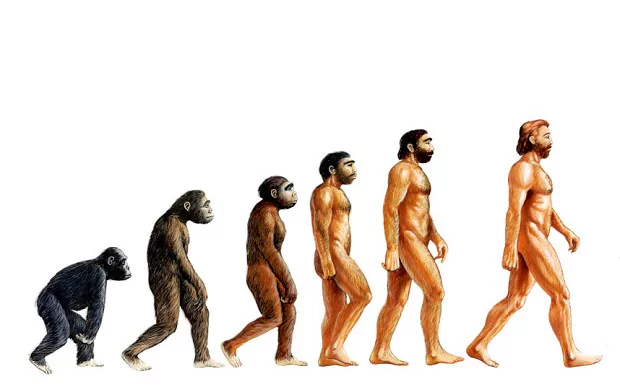 Image showing stages of evolution. Image source
Image showing stages of evolution. Image source
Eugenics
Eugenics (Greek for good genes) is a science of increasing breeding (reproduction) of the considered to be superior groups and suppressing the growth of the selected to be inferior groups in order to improve the quality of human population by getting desirable genetic characteristics.
The superior population in society was often the rich, the educated, the healthy and often a particular race like White people. The inferior on the other side was the disabled, mentally disturbed, sick, immigrants, criminals and often a particular race like Black people. Sexual relationship between the superior and the inferior was often prevented as it would mix and spoil the good bloodline that was desired.
This theory of eugenics was influenced by the increased confidence in science as the most reliable and efficient way of understanding the world which was popular in the 19th century. It was developed by the English writer Francis Galton. He believed that in the interest of “survival of the fittest” the poor and the weak should be left to remain so, as it only meant they were in the early stage of evolution, while the “superior” should be encouraged for the benefit of a good and healthy population.
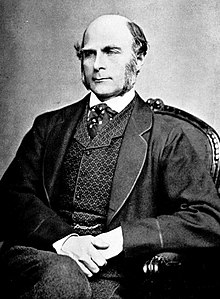 Francis Galton Image source
Francis Galton Image source
Positive Eugenics
Eugenics played a positive role in promoting health and on family planning. Countries who believed in eugenics such as the United States of America, Britain, Sweden, India and China encouraged good health of the superior groups. They encouraged these superior groups to exercise and eat healthy. These governments did this by building public swimming pools and sport grounds for the superior groups, hoping to develop populations with good genes; they also encouraged women who were considered healthy to have children for the same purpose of getting good genes.
Negative Genes
On the other side the said to be inferior groups were sterilised, sometimes by force. For instance in USA, between 1907 and 1943, sterilization laws were passed in 30 states. This was done to prevent growth of the inferior kind. To prevent them from growing in population, the inferior population was also made to take contraceptive pills (birth control pills).
Race today
Today eugenics are discouraged, and not only considered to be wrong but also to be violating human rights. In the 1990s it was discovered that all people have a “mutual ancestor” which originated in Africa because the earliest human remains (about 200 000 years old) were found in Africa.
Scientists had also discovered that there were no fixed or consistent differences in race in terms of characteristics like physical features. In other words scientists had discovered that not all Black people have round lips, not all white people have sharper noses, and not all Asians have small eyes, as it was believed by Eugenicist in the 19th century.
Many people argue that the word 'race' should no longer be used for the following reasons:
- Most scientists today would say that there is no such thing as race.
- The misinterpretation of the term 'race' to classify people has gone hand in hand with contempt (violation) for human rights.
Race in USA
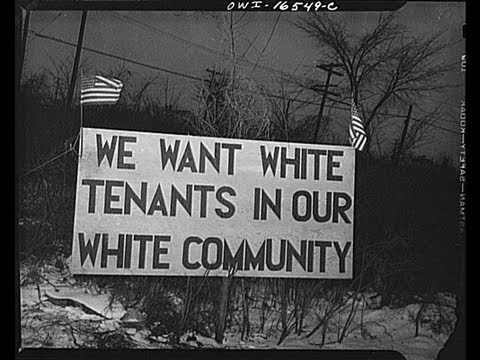 A billboard in the 1950s in USA. Image source
A billboard in the 1950s in USA. Image source
In the 19th century Pseudo-Scientific theories about race were also used in USA. The government treated Native Americans and African Americans as inferiors, while it treated whites as superiors.
By this time (19th Century) thousands of Native Americans had been killed by starvation (excessive hunger) and the diseases that they caught from Europeans and which they were unable to treat. The white settlers had defeated Native Americans in war battles for land and had had taken their land.
On the other side, in the 1950s African Americans were discriminated against by the segregation laws that were laid in different states in USA. There were segregation laws in public facilities such as transports, schools, parks and restaurants.
African Americans’ facilities were often poor in service and in quality compared to the whites’ facilities. For instance African Americans’ schools were often over populated and lacked resources, while whites’ schools had fewer pupils in a classroom and had good infrastructure.
The inferior groups being the Native Americans and the African Americans were left to suffer with little help, if any, from the government. This was part of the “survival of the fittest” idea and was in line with the USA’s capitalist system, where certain inpiduals in society had more power in business, or politics.
Race in Namibia
 A map showing the Kalahari Desert in which Herero were driven to by German colonialists. Image source
A map showing the Kalahari Desert in which Herero were driven to by German colonialists. Image source
Namibia became a German colony in 1884, and was called South West Africa. The Germans had arrived in Namibia as part of European immigration to different colonies, which was popular at that time and was associated with superiority.
When they arrived in South West Africa the country was occupied by the Nama (Khoi people) and Herero farmers. The Germans then began to remove the Herero and Namas from south West Africa to the Kalahari Desert. The Hererofought back in what became known as the Herero Revolt.
Race in South Africa
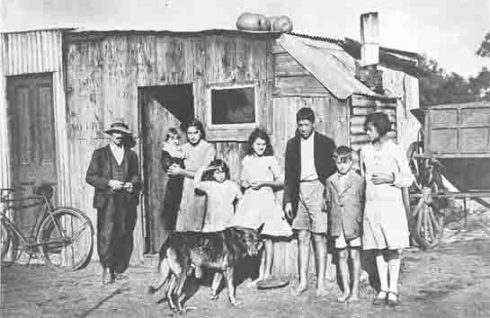 Poor Afrikaners in South Africa during the 1920s. Image source
Poor Afrikaners in South Africa during the 1920s. Image source
South Africa had laws that relied on eugenics as truthful facts about race. In South Africa mating and sexual intercourse between the said to be inferior groups and the superior groups was prevented because it would lead to an inferior population. These laws existed even before Apartheid in South Africa. They included the Immorality Act of 1927 which prevented sexual relationships between White and Black South Africans.
In the 1930s the South African Government controlled breeding of the inferior groups, which included poor whites (largely Afrikaners) due to the Great Depression. In the 1930s the South African government created a programme called the "Race Welfare Society" to control births among poor white females and encourage them to have smaller families that they could manage to take care of in terms of finances.
Although in the 1930s the South African Government had these laws and programmes that were fuelled by the theories of Eugenics, unlike USA it never practiced sterilisation. This was because of two reasons (i) the validity and fairness of eugenics policies was beginning to be doubted in Britain, and (ii) in the 1930s was the rise of Afrikaners to power therefore large families were encourage to make the Afrikaners nation stronger.
Case study: Australia and the indigenous Australians
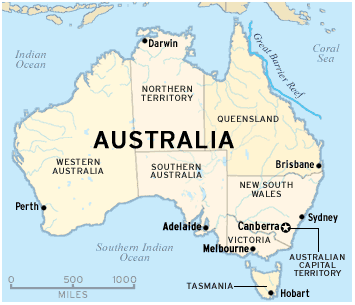 A map showing Australia. Image source
A map showing Australia. Image source
The Aborigines were the indigenous people of Australia, who had lived there long before Europeans arrived. They were hunt-gatherers so they used to move around Australia in search of food and better climate.
By the 1780s the British already had plans about Australia (i) they wanted Australia to be its penal colony, where British convicts would be sent (ii) they wanted to claim Australia as its territory first before competing colonialists like France did.
The British began to put their plans into action; they cut down trees, built houses and started planting in Australia. The settlers together with their convicts first arrived at New South Wales (NSW), then to the Island of Van Diemen's Land (today known as Tasmania) and Perth (which was called the Swan River).
When gold was first discovered in Melbourne’s capital Victoria, miners from Britain, China and Ireland filled the region in search of gold. By the 1900s the British empires in Australia were already well established. In 1901 the British empires in Australia formed their own government, the Australian Federation.
The British settlers in Australia did not recognise the rights of the Aborigines by denying them their land and their food (as the British had cut all trees where Aborigines used to find food). This made the Aborigines to rely on the settlers. The Aborigines worked for the British settlers as farm labours or domestic workers. They were paid very low wages, as a result of large numbers of Aborigines became poor and were easy victims of diseases like smallpox brought by European settlers.
Thousands of Aborigines died from starvation, and diseases such as smallpox. This has left Historians debating whether these deaths of Aborigines could be blamed on Europeans as acts of genocide or whether these deaths as a result of the Aborigine’s failure to adapt to change.
Debates on racial suicide and racial decay
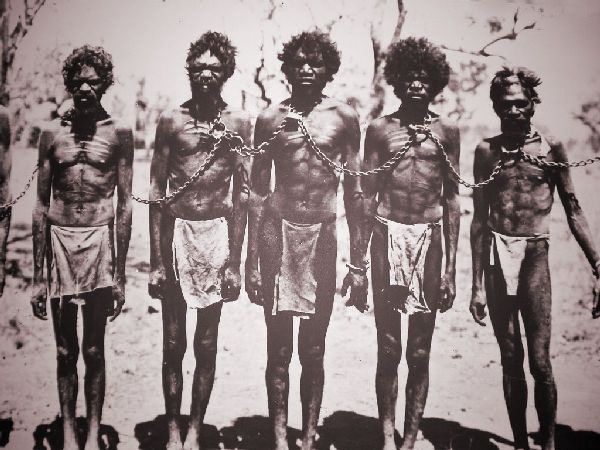 Ill-treatment of the Aborigines upon the arrival of European settlers in Australia Image source
Ill-treatment of the Aborigines upon the arrival of European settlers in Australia Image source
As established before that European' cruelty on Aborigines was justified by Pseudo-Scientific theories like Social Darwinism which were largely believed in the 19th century. These theories regarded the Aborigines as inferiors who were at the early stages of evolution, and who could not compete with Europeans as Europeans were at the advanced stages of development.
Some of the laws which were fuelled by Social Darwinism that were passed by the Europeans upon the Aborigines meant that the Aborigines were prohibited from voting, owning dogs and carrying guns. Intermarriage between the Aborigines and white people required special permission from the government. Aborigines were moved to reserves by force
Among Europeans there were debates on what should be done by the then believed to be valid "Social Darwinism" with regard to aborigines.
a handful of Europeans wanted the Aborigines to integrate into European Society
Some believe that the Aborigines should be kept in places of safety, outside the European society
some felt that the Aborigines should be kept segregated from the settlers’ society because they were inferior
Nazi Germany and the Holocaust
 Adolf Hitler Image source
Adolf Hitler Image source
In 1933, Adolf Hitler, leader of the Nazi was put into power as the Chancellor of Germany by other politicians who had hoped that his party (Nazi Party) would bring economic change in Germany's economic crisis.
The Nazis were Fascists, they believed in law, obedience and order above everything else. They implemented (applied) their fascists ideas in Germany, where they (i) believed in absolutism ( total control), (ii) saw war as natural and necessary to human kind to bring order (ii) they did not believe in Democracy.
In a matter of a year in power, the Nazis had turned Germany into a totalirian, where the Government (the Nazi Party) had absolute control over Germany. Under Hitler’s Government, this is what happened:
- Hitler had total control over legislature (law).
- Those who criticised him were sent to concentration camps (detention camps) often to be trained to perform brutal acts under the Nazis.
- Political opposition parties were banned.
- The education system in Germany emphasised Nazi ideologies, text-books were re-written in order to be in line with Nazi movement.
- German youth was required to join the Hitler Youth (HJ), which supported the Nazi Movement.
- Hitler ended up controlling the German army as well. At first, the officials of the German army did not want him on board because of his violent nature. Hitler then ordered a murder of army leaders who had rejected him. After the army officials were murdered he was allowed in the army as the Commander-in-Chief. He then required the officials of the army to swear an oath of loyalty to him.
- After Germany was defeated in the Second World War, it had lost many of its soldiers and weapons. To strengthen the army, Hitler ordered that it was compulsory for all young men to join the army. This made Germany one of the most powerful nations in Europe in terms of Military.
Eugenics in Germany
The Nazis believed in eugenics, where according to them the blue-eyed, blonde and tall Europeans whom they called the Aryan race were at the advanced stage of development that other people, and thus should be on top of the hierarchy in society. The Nazis believed that the extermination (killing of a whole group) of the inferior people was a progress of human kind. The Nazis were also inspired by the eugenics works in USA such as sterilisation programmes for inferior population.
 Image showing ideal pictures of the Aryan race. Image source
Image showing ideal pictures of the Aryan race. Image source
Negative Eugenics in Germany
Like the USA, the Nazis forced the inferior population to be sterilised. They removed the mentally-ill people and people with disabilities from society to separate institutions. In these institutions the mentally-ill and people with disabilities were often used for cruel scientific experiments, they were also murdered by Euthanasia (put to death in a painless was normally due to incurable diseases).
Promotion of the Master Race blood
Women who were considered to be members of the Master race were encouraged to give more births to promote the master race blood. They were discouraged from working, and encouraged to stay at home and raise children.
Which groups were not “Master Race” or “Aryan Race”
Groups which were not regarded as “master races” were killed in millions by the Nazis. If not killed, the inferior groups were often sent to work as farm labours or domestic workers, some were killed in masses, other sterilised and some sent to concentration camps. These people included:
- Unemployed people
- People with disabilities
- Mentally-ill people
- Criminals
- Black people
- Homosexuals
- Political opponents
- Immigrants
- Jews were the main victims, the Nazis aimed to kill all of the Jews in a policy of genocide. The Nazi killed six millions of the nine millions Jews in Germany. In what was called “the Holocaust”
Who supported the Nazis
Supporters of the Nazi were mostly the “master Race” whose economic crisis was improved by the Nazi. They did not care about the cruelty of the Nazis as long as they were not harmed.
Who did nothing about the Nazi
Some Germans were simply scared of the Nazis. This was because the Nazis were cruel to those who opposed them, so many Germans chose to keep quiet and pretend nothing was happening, for their own safety.
Those who resisted against the Nazi policies
The White Rose Movement
This was a group of students at Munch University who were executed for criticising Hitler. They were led by their philosophy lecturer. They were caught while they were distributing anti-Nazi pamphlets. Although the movement lasted for less than a year (from June 1942 until February 1943), they managed to make six pamphlets on different Anti-Nazi topics.
Rescuers
Some Germans from the “master race” risked their lives and helped Jews hide in their houses or help them escape.
While religious movements like the Quackery Movement which was an anti-violence religious group who smuggled 2500 Jewish children out of Germany into England, also came to the rescue of the Jews.
The Final Solution
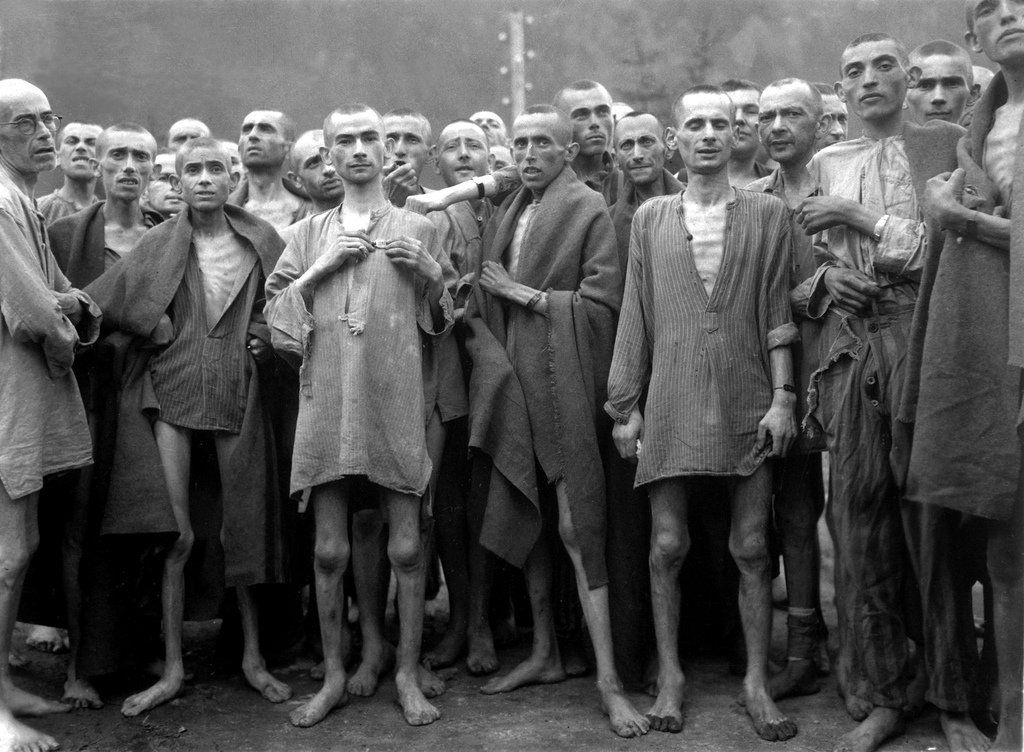 Starving men in the Nazi concentration camps. Image source
Starving men in the Nazi concentration camps. Image source
The campaign against Jews was introduced bits by bits with the last more severe than the previous.
- At first the Nazis encouraged boycotts against Jewish-owned-shops and terrorised these shops
- In June 1933 Jews were fired and prohibited from working in civil services.
- In 1935 the Nazi government passed Nuremburg laws which banned Jews from sports fields or universities or Museums.
- In November 1938 a Jew man assassinated a German diplomat in Paris, this made the Nazis upset and destroyed Jewish-owned-shops and Jews’ homes in Germany. This was called Kristallnacht (German for “Night of broken glass”) because thousand s of pieces of broken glasses laid on the streets as a result of the attacks of the Jewish shops. Jews, in large numbers, were then forced into concentration camps and were sent into hard labour.
- In 1939, after the Second World War, almost the whole of Eastern Europe (where Jews were in large numbers) was under the control of Nazis, who forced the Jews into overpopulated ghettos.
The Nuremberg Trials
In May 1945 Nazi Germany surrendered to the Allied armies (which consisted of Britain, the USA and the USSR) (see grade 12, topic 1). Hitler committed suicide. Other Nazi leaders also committed suicide.
The allies punished the remaining Nazi leaders. They first put them in an international court at Nuremberg for trial, where they were convicted of crimes associated with human rights violation. Thousands of Nazis and their helpers (like the doctors that performed the cruel euthanasia on the mentally-disturbed), were found guilty, their sentences varied from death sentences and prison sentences.